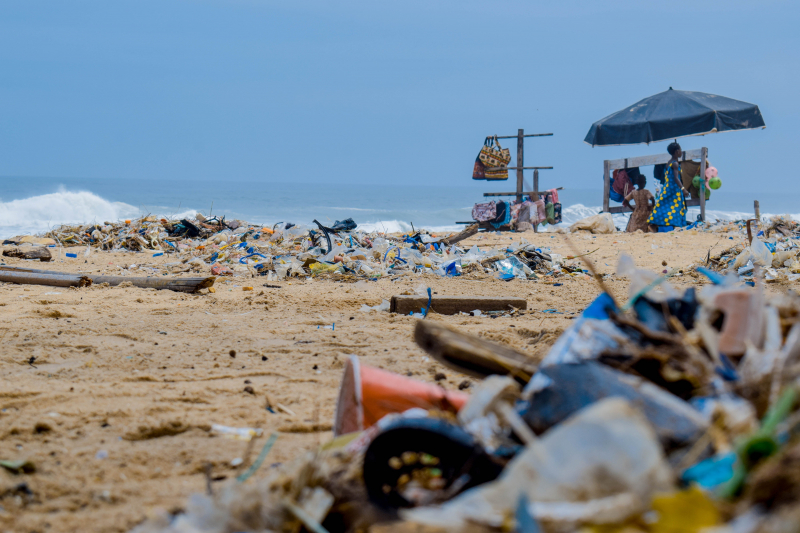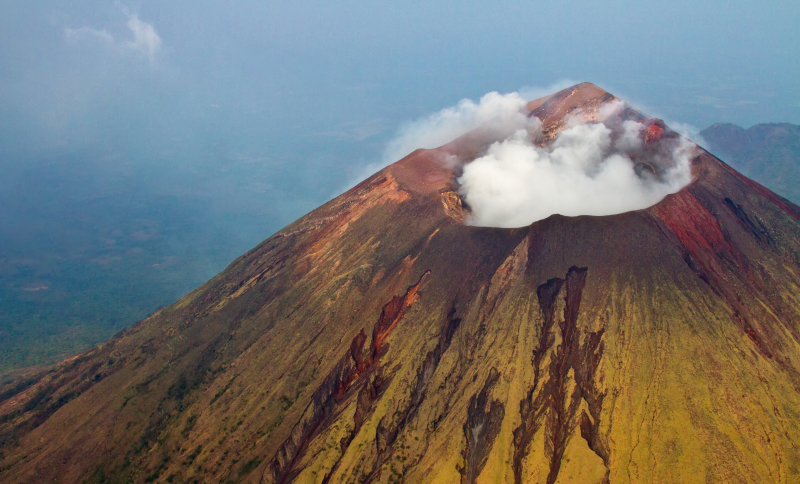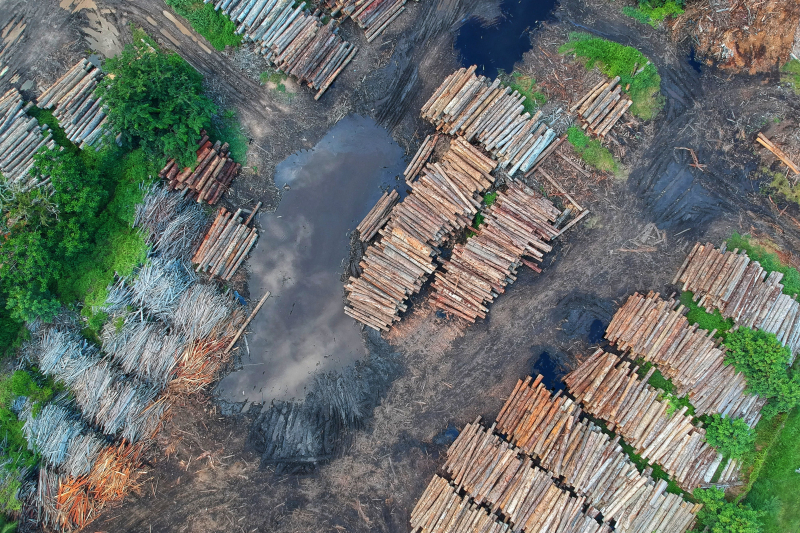Top 10 Cause and Effect Essay Topics about Environment and Samples
Cause and effect essays dissect actions and consequences, crucial for addressing environmental challenges. Explore the top 10 essay topics in this article to ... read more...inspire positive change.
-
Essay topic: Describe the cause and effect of urbanization on the environment
Answer:
Urbanization, the rapid growth and expansion of cities, has become a defining feature of the modern era. While it brings about economic development and improved living standards, it also exerts profound effects on the environment. This essay explores the causes and effects of urbanization on the environment, highlighting the complex interplay between urban development and ecological well-being.
One of the primary causes of environmental degradation associated with urbanization is the increase in industrialization and infrastructure development. As cities expand, so does the demand for housing, transportation, and energy. Consequently, forests are cleared, and ecosystems are disrupted to make way for urban infrastructure. This leads to habitat loss for numerous species, upsetting the delicate balance of ecosystems.
Another significant cause of environmental challenges resulting from urbanization is the surge in resource consumption. As cities burgeon, there is an escalating demand for resources such as water, energy, and raw materials. The extraction and utilization of these resources often lead to environmental degradation. For instance, excessive water extraction for urban needs can deplete aquifers and compromise the natural flow of rivers, affecting aquatic ecosystems and causing water scarcity in surrounding areas.
Furthermore, the surge in population density in urban areas intensifies pollution. Increased vehicular traffic, industrial emissions, and improper waste disposal contribute to air and water pollution. The release of pollutants into the atmosphere not only degrades air quality but also contributes to climate change, with long-term implications for global ecosystems.
The effects of urbanization on the environment are far-reaching. Loss of green spaces and the proliferation of impervious surfaces contribute to the urban heat island effect, causing localized temperature increases. This phenomenon exacerbates heat-related illnesses and strains energy resources for cooling. Additionally, the altered hydrological cycle in urban areas leads to increased incidents of flooding and soil erosion.
In conclusion, urbanization, driven by industrialization and population growth, has profound implications for the environment. The causes are rooted in the demand for urban infrastructure, resulting in habitat destruction and increased pollution. The effects manifest in the form of climate change, loss of biodiversity, and altered ecosystems. Recognizing the intricate relationship between urban development and the environment is crucial for implementing sustainable practices and mitigating the negative impacts of urbanization on our planet.

Photo by Gül Işık via pexels 
Photo by Peng LIU via pexels -
Essay topic: What are the causes and consequences of plastics on marine life'
Answer:
Plastic pollution has emerged as a grave environmental concern, particularly in marine ecosystems, where its consequences are both far-reaching and devastating. This essay delves into the causes of plastic pollution and its profound effects on marine life, shedding light on the intricate relationship between human activities and the well-being of our oceans.
One of the primary causes of plastics in marine environments is irresponsible waste disposal. Inadequate waste management systems and improper disposal practices allow plastics to find their way into rivers and oceans. Additionally, the extensive use of single-use plastics, such as bottles, bags, and packaging, exacerbates the problem. The convenience of these products comes at a significant cost to marine ecosystems as they persist in the environment for hundreds of years, slowly breaking down into smaller, more harmful particles.
Another significant cause of plastics impacting marine life is the fragmentation of larger plastic items into microplastics. Over time, due to the sun's ultraviolet rays, wind, and wave action, larger plastic debris in the oceans breaks down into tiny particles, often invisible to the naked eye. These microplastics then permeate marine ecosystems, posing a pervasive threat. These minute particles are not only challenging to clean up but are also readily ingested by a wide range of marine organisms, from plankton to filter-feeding whales.
The consequences of plastics on marine life are multifaceted. The most visible impact is the entanglement of marine animals in plastic debris. Sea turtles, dolphins, and seabirds often become ensnared in discarded fishing nets and plastic waste, leading to injury or death. Furthermore, marine organisms mistake plastic particles for food, as they can resemble prey. Ingestion of plastics by marine species disrupts their digestive systems, leading to malnutrition, internal injuries, and, in some cases, death.
Plastic pollution also introduces toxic chemicals into marine ecosystems. The breakdown of plastics over time releases harmful substances into the water, posing a threat to marine life at various levels of the food chain. As smaller organisms ingest these toxins, they accumulate in the tissues of larger predators, including fish that are later consumed by humans. This creates a potential health risk for both marine life and humans dependent on seafood.
In conclusion, the causes of plastic pollution in marine environments are deeply rooted in human behaviors, particularly irresponsible waste disposal and the prevalent use of single-use plastics. The consequences are severe and include physical harm to marine animals, ingestion of toxins, and the contamination of the food chain. Recognizing the gravity of this issue is imperative for implementing effective waste management strategies and reducing the reliance on plastics to safeguard the health of our oceans and the myriad species that inhabit them.

Photo by Lucien Wanda via pexels 
Photo by Nataliya Vaitkevich via pexels -
Essay topic: Causes and Impacts of Rising Sea Temperatures on Fish and Marine Life
Answer:
Rising sea temperatures, primarily driven by climate change, have emerged as a critical environmental concern with profound consequences for fish and marine life. This essay examines the causes behind the increasing sea temperatures and the far-reaching impacts on aquatic ecosystems, emphasizing the interconnectedness of climate and marine health.
One of the primary causes of rising sea temperatures is the excessive emission of greenhouse gases, such as carbon dioxide and methane, into the Earth's atmosphere. Human activities, including the burning of fossil fuels and deforestation, contribute to the greenhouse gas effect, trapping heat and leading to a rise in global temperatures. As the Earth warms, oceans absorb a significant portion of this heat, resulting in elevated sea temperatures. Additionally, changes in ocean currents and circulation patterns further contribute to the warming trend.
Another critical cause of rising sea temperatures is the phenomenon known as ocean acidification, which results from the absorption of excess carbon dioxide by seawater. As atmospheric carbon dioxide levels rise due to human activities, a substantial portion is absorbed by the oceans. While this mitigates the impact of climate change to some extent, it triggers chemical reactions in the seawater, leading to a decrease in pH levels.
The impacts of rising sea temperatures on fish and marine life are multifaceted. Fish species, particularly those sensitive to temperature changes, are forced to migrate to cooler waters, disrupting traditional migration patterns and altering the distribution of marine populations. Some species may find themselves in unsuitable habitats, leading to a decline in their abundance. Moreover, higher water temperatures can affect the metabolic rates and reproductive capacities of fish, influencing their growth and survival.
Coral reefs, crucial ecosystems that support diverse marine life, are particularly vulnerable to rising sea temperatures. Elevated temperatures cause coral bleaching, a phenomenon where corals expel the symbiotic algae living in their tissues, resulting in a loss of color and a breakdown of the coral-algae relationship. The subsequent degradation of coral reefs diminishes the habitats and food sources for many marine species, leading to a decline in overall biodiversity.
In conclusion, the causes of rising sea temperatures are rooted in human-induced climate change, specifically the release of greenhouse gases. The impacts on fish and marine life are significant, affecting migration patterns, reproductive success, and the health of vital ecosystems like coral reefs. Recognizing and addressing the root causes of rising sea temperatures are essential for preserving the delicate balance of marine ecosystems and safeguarding the countless species that depend on them for survival.

Photo by Maurício Mascaro via pexels 
Photo by Pixabay via pexels -
Essay topic: Causes and Effects of Volcanic Eruptions
Answer:
Volcanic eruptions, awe-inspiring natural phenomena, are driven by complex geological processes that have both immediate and far-reaching consequences. This essay explores the causes behind volcanic eruptions and their multifaceted effects on the environment and surrounding communities.
Volcanic eruptions primarily result from the movement of tectonic plates beneath the Earth's surface. The Earth's outer shell is divided into several large plates that float on the semi-fluid asthenosphere beneath them. These plates are in constant motion, and when they interact, they can create convergent, divergent, or transform boundaries. As the subducted plate descends into the Earth's mantle, it melts due to the intense heat and pressure, forming magma. This magma, being less dense than the surrounding rock, rises towards the surface, leading to volcanic activity.
Explosive eruptions occur when magma is thick and gas-rich, creating pressure that results in violent explosions. These eruptions often release ash, volcanic gases, and pyroclastic flows, endangering both local environments and global air travel. Effusive eruptions, on the other hand, involve the relatively slow release of less viscous magma, allowing it to flow more freely. While less explosive, effusive eruptions can still cause lava flows that pose a threat to nearby communities and ecosystems.
The effects of volcanic eruptions are diverse and impactful. In addition to the immediate dangers posed by lava flows, ashfall, and pyroclastic flows, volcanic activity can contribute to long-term environmental changes. The release of volcanic gases, including sulfur dioxide, can lead to the formation of acid rain, negatively impacting soil, water bodies, and vegetation. Moreover, volcanic ash ejected into the atmosphere can influence global climate patterns by reflecting sunlight and causing temporary cooling.
In conclusion, volcanic eruptions are a result of the dynamic geological processes occurring beneath the Earth's surface, primarily driven by tectonic plate movements. The effects of these eruptions range from immediate dangers to long-term environmental changes, highlighting the intricate relationship between geological forces and the delicate balance of our planet. Understanding these causes and effects is crucial for mitigating the impact of volcanic eruptions and ensuring the safety and resilience of communities in volcanic regions.

Photo by ROBERTO ZUNIGA via pexels 
Photo by Daniel Torobekov via pexels -
Essay topic: Causes and Effects of Species Endangerment
Answer:
The endangerment of species is a critical environmental issue that results from a complex interplay of various factors. This essay explores the causes behind the decline of species and the far-reaching effects on ecosystems and biodiversity.
One primary cause of species endangerment is habitat loss and fragmentation. Human activities, such as deforestation, urbanization, and agriculture, lead to the destruction and fragmentation of natural habitats. As these habitats shrink, species lose their homes and struggle to find suitable environments for feeding, breeding, and shelter. The fragmentation of habitats further isolates populations, making it difficult for individuals to find mates and perpetuate their species.
Human-induced factors, including pollution and climate change, contribute significantly to species endangerment. Pollution, whether from industrial discharges, agricultural runoff, or plastic waste, can contaminate air, water, and soil, affecting the health and survival of various species. Climate change, driven by the accumulation of greenhouse gases, alters temperature and precipitation patterns, disrupting ecosystems and making it challenging for species to adapt or migrate to more suitable environments.
Overexploitation is another cause of species endangerment. The unsustainable hunting, fishing, and harvesting of species for economic gain or cultural practices can lead to population declines and, in extreme cases, extinction. This overharvesting disrupts the delicate balance of ecosystems and can have cascading effects on other species dependent on the endangered ones for food or other ecological interactions. The effects of species endangerment are profound and extend beyond the loss of individual species.
Biodiversity, the variety of life on Earth, is crucial for ecosystem stability and resilience. The decline or loss of a species can disrupt food webs, reduce genetic diversity, and diminish the overall health of ecosystems. Furthermore, the extinction of one species may trigger a domino effect, affecting the survival of others that were interconnected in complex ecological relationships.
In conclusion, the causes of species endangerment are multifaceted, stemming from human activities that alter or destroy natural habitats, introduce pollutants, and exploit species beyond sustainable levels. The effects go beyond the disappearance of individual species, impacting the overall health and functioning of ecosystems. Recognizing and addressing these causes is essential for conservation efforts aimed at preserving biodiversity and ensuring the continued existence of diverse life forms on our planet.

Photo by Elena Blessing via pexels 
Photo by Francesco Ungaro via pexels -
Essay Topic: Causes and Effects of Animals Losing Their Habitats
Answer:
The loss of animal habitats has become a critical environmental issue, driven by various factors that significantly impact both wildlife and ecosystems. This essay explores some of the key causes behind habitat loss and its far-reaching effects on animal populations and ecological balance.
One prominent cause of habitat loss is human activities, particularly deforestation and urbanization. As human populations expand, there is an increasing demand for land for agriculture, logging, and infrastructure development. This leads to the clearing of vast areas of natural habitats, displacing countless species. Deforestation, driven by logging and the conversion of forests into agricultural land, is particularly detrimental to many terrestrial species that rely on these habitats for food, shelter, and breeding grounds.
Urbanization exacerbates habitat loss as cities expand and infrastructure projects encroach upon natural landscapes. This not only reduces the available living space for animals but also fragments habitats, making it difficult for species to move between isolated patches. Roads and other structures act as barriers, further isolating populations and hindering their ability to find mates or access essential resources.
The effects of habitat loss are profound and often lead to declines in animal populations and biodiversity. Many species face heightened competition for limited resources in smaller, fragmented habitats, leading to increased stress and decreased reproductive success. Some animals become more susceptible to predation, while others struggle to find suitable conditions for breeding and raising offspring.
Moreover, habitat loss disrupts intricate ecological relationships. Animals that serve as pollinators or prey for other species may decline, affecting the entire food web. The loss of biodiversity can also result in a reduction of ecosystem services, such as water purification and climate regulation, which are vital for human well-being.
In conclusion, the causes of animals losing their habitats are closely tied to human activities, particularly deforestation and urbanization. The effects extend beyond individual species, impacting ecosystems and the services they provide. Recognizing the importance of preserving habitats and implementing conservation measures is crucial for mitigating the loss of biodiversity and ensuring the long-term survival of diverse animal species on our planet.

Photo by Osman Arabacı via pexels 
Photo by Bongani Nkwinika via pexels -
Essay topic: Causes and Effects of Antarctic Floods
Answer:
Antarctica, a continent known for its vast ice sheets and extreme cold, is experiencing changes that have given rise to a concerning phenomenon: Antarctic floods. This essay explores the causes behind these floods and the consequential effects on the continent's delicate ecosystems and global sea levels.
The primary cause of Antarctic floods is the warming climate. As global temperatures rise, the Antarctic region is not immune to the effects of climate change. Warmer temperatures lead to the melting of ice sheets and glaciers, releasing large volumes of water. The increased frequency and intensity of rainfall in some areas of Antarctica exacerbate this process, contributing to the formation of temporary lakes on the ice surface.
The melting of Antarctic ice has profound effects on the continent's ecosystems. One notable consequence is the alteration of habitats for indigenous species, such as penguins and seals, which depend on stable ice conditions for breeding and foraging. Changes in the availability of food and nesting sites can impact the reproductive success and overall health of these iconic Antarctic animals.
Moreover, the influx of freshwater from melting ice contributes to rising sea levels globally. As the ice on Antarctica continues to melt, vast quantities of freshwater are introduced into the surrounding oceans. This, in turn, contributes to the ongoing trend of sea level rise, posing threats to coastal communities worldwide.
The melting of Antarctic ice also has implications for the stability of ice shelves. Increased surface melting can lead to the weakening and eventual collapse of ice shelves, accelerating the flow of glaciers into the ocean. This process not only contributes to sea level rise but also alters ocean circulation patterns, with potential repercussions for global climate systems.
In conclusion, the causes of Antarctic floods are intricately linked to the broader issue of climate change, particularly the warming of the Antarctic region. The effects extend beyond local ecosystems, impacting global sea levels and climate systems. Recognizing the urgency of addressing climate change and implementing measures to mitigate its impact on Antarctica is crucial for the preservation of the continent's unique environment and the stability of our planet's climate.

Photo by GEORGE DESIPRIS via pexels 
Photo by hitesh choudhary via pexels -
Essay Topic: Causes and Impacts of Deforestation in Brazil
Answer:
Deforestation in Brazil has become a pressing environmental issue with far-reaching consequences for ecosystems, biodiversity, and global climate patterns. This essay examines the causes behind the widespread deforestation and its multifaceted impacts on both the environment and human societies.
One primary cause of deforestation in Brazil is agricultural expansion, driven by the demand for land for cattle ranching and soybean cultivation. As one of the world's largest exporters of beef and soy, Brazil has witnessed substantial clearing of forests, particularly in the Amazon basin. Large-scale agricultural operations often employ slash-and-burn techniques to clear land quickly, leading to extensive loss of tropical rainforests.
Logging activities also contribute significantly to deforestation in Brazil. The extraction of valuable timber, often driven by economic interests, results in the removal of large areas of forest. Additionally, illegal logging exacerbates the issue, further depleting valuable forest resources and undermining conservation efforts.
The impacts of deforestation in Brazil are profound. One immediate consequence is the loss of biodiversity as countless plant and animal species lose their natural habitats. The Amazon rainforest, for example, is home to a staggering array of species, many of which are found nowhere else on Earth. The destruction of these habitats threatens these unique ecosystems and contributes to the global biodiversity crisis.
Moreover, deforestation plays a key role in climate change. Forests act as carbon sinks, absorbing and storing large amounts of carbon dioxide. When trees are cut down or burned, this stored carbon is released into the atmosphere, contributing to the greenhouse effect and global warming. The Amazon rainforest, often referred to as the "lungs of the Earth," plays a crucial role in regulating the planet's climate by absorbing carbon dioxide and producing oxygen.
In conclusion, the causes of deforestation in Brazil are deeply rooted in agricultural expansion and logging activities. The effects extend beyond local ecosystems, impacting global biodiversity and contributing to climate change. Recognizing the importance of sustainable land use practices and implementing conservation measures is crucial for mitigating the impacts of deforestation and preserving the invaluable natural resources of Brazil.

Photo by Pok Rie via pexels 
Photo by Matthis Volquardsen via pexels -
Essay topic: Causes and Effects of Pollution on the Ocean
Answer:
Pollution in the ocean has become a critical environmental issue, posing severe threats to marine life and ecosystems. This essay delves into the causes of ocean pollution and explores its cascading effects on the delicate balance of marine environments.
One significant cause of ocean pollution is industrial discharge. Factories and manufacturing facilities often release pollutants directly into water bodies, introducing chemicals, heavy metals, and toxins into the ocean. These substances can have detrimental effects on marine organisms, disrupting their physiology, reproductive cycles, and overall health. Oil spills, another form of industrial pollution, have catastrophic consequences, coating marine habitats and devastating wildlife.
Agricultural runoff represents another major contributor to ocean pollution. The use of fertilizers and pesticides in farming activities leads to the runoff of these chemicals into rivers and ultimately the ocean. Excessive nutrient runoff can result in harmful algal blooms, depleting oxygen levels in the water and creating "dead zones" where marine life cannot thrive. The disruption of the marine food web and the loss of biodiversity are direct consequences of this type of pollution.
Plastic pollution is a pervasive and visible form of ocean contamination. Improper disposal of plastic waste, along with the breakdown of larger plastic items into microplastics, has become a significant threat to marine life. Animals such as sea turtles, fish, and seabirds often mistake plastic debris for food, leading to ingestion and subsequent health issues. Additionally, the accumulation of microplastics in the ocean poses long-term risks, as these particles can enter the food chain, affecting human health as well.
The effects of ocean pollution are far-reaching. Marine ecosystems, already vulnerable to climate change and overfishing, face additional stressors from pollution. Coral reefs, vital habitats for numerous species, are particularly sensitive to water contamination. Pollution can lead to coral bleaching, a phenomenon that weakens and eventually kills the corals, depriving countless marine organisms of their homes and breeding grounds.
In conclusion, the causes of ocean pollution are diverse, ranging from industrial discharges and agricultural runoff to plastic waste. The effects extend beyond marine life, affecting ecosystems, biodiversity, and even human health. Recognizing the urgency of addressing these causes and implementing sustainable practices is crucial for the preservation of the oceans and the myriad species that depend on them.

Photo by Ron Lach via pexels 
Photo by 7inchs via pexels -
Essay topic: Causes and Effects of Climate Change on Our Environment
Answer:
Climate change, a global phenomenon driven by human activities, has profound and far-reaching effects on our environment. This essay explores the causes behind climate change and examines its multifaceted impacts on ecosystems, weather patterns, and the overall health of the planet.
One of the primary causes of climate change is the increased concentration of greenhouse gases in the Earth's atmosphere. Human activities, such as burning fossil fuels for energy, deforestation, and industrial processes, release large amounts of carbon dioxide, methane, and other greenhouse gases. These gases trap heat in the atmosphere, leading to a warming effect commonly referred to as the greenhouse effect.
The consequences of climate change on our environment are diverse and impactful. Rising temperatures are altering weather patterns, leading to more frequent and intense extreme weather events. Heatwaves, droughts, floods, and hurricanes are becoming more prevalent, posing threats to human communities, agriculture, and natural ecosystems.
Melting ice caps and glaciers are another visible effect of climate change. The warming climate accelerates the loss of ice in polar regions and mountainous areas, contributing to rising sea levels. This phenomenon poses a significant risk to low-lying coastal regions, leading to increased instances of flooding and saltwater intrusion into freshwater sources.
Ocean acidification is a direct consequence of climate change. The absorption of excess carbon dioxide by the oceans leads to changes in seawater chemistry, resulting in increased acidity. This acidification poses a threat to marine life, particularly organisms with calcium carbonate skeletons or shells, such as corals, mollusks, and certain types of plankton.
Furthermore, climate change disrupts ecosystems and threatens biodiversity. Species that are unable to adapt quickly enough to changing conditions face extinction, leading to imbalances in food webs and loss of genetic diversity. Shifts in temperature and precipitation patterns can also impact the distribution and abundance of plant and animal species, affecting agricultural productivity and food security.
In conclusion, the causes of climate change are rooted in human activities that release greenhouse gases into the atmosphere. The effects are wide-ranging, affecting weather patterns, ice melting, sea levels, ocean acidity, and biodiversity. Recognizing the urgency of addressing these causes and implementing sustainable practices is crucial for mitigating the impacts of climate change and preserving the health and balance of our environment.

Photo by Pixabay via pexels 
Photo by Kallie Calitz via pexels































